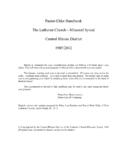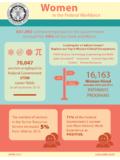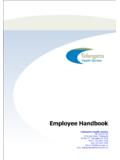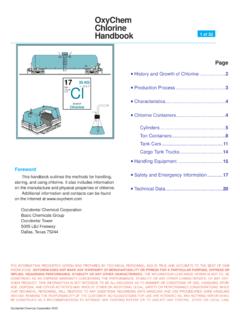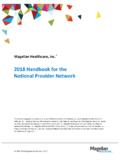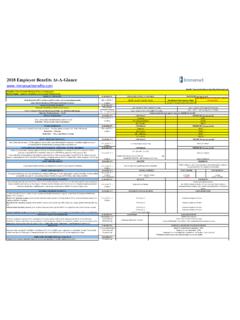Transcription of A Guide to Elder Care Options ELDER CARE handbook
1 ELDERCARE handbookA Guide to ELDER CareOptionsLavoie-Vaughan, N. (2014). ELDER care handbook . (A. Moyer, Ed.). Raleigh, NC: Workplace Options . Copyright 2015 by Workplace OptionsTable of ContentsIntroduction 4 Common Changes ..4 Aging Gracefully ..4 Planning for the Future 5 Managing the Physical Changes of Aging 8 Vision and Hearing ..8 Falls ..8 Incontinence ..9 Constipation.
2 9 Medication Management ..10 Managing the Mental Changes of Aging 10 Memory Loss: Prevention ..10 Memory Loss: Treatment ..11 Maintaining Brain Health ..11 Aging in Place 11 Warning Signs That an ELDER Needs Help 13 Options for care 14 Cost of You Need to Know 16 Medicare.
3 16 Medicaid ..16 Veteran s Benefits ..17 Long-Term care Insurance ..17 Questions to Ask When Touring a Skilled Nursing Facility ..18 How to Find Ratings for a Skilled Nursing Facility ..19 Hospice Eligibility Guidelines ..19 Using the Services of a Geriatric care Manager ..19 What to Take to Medical Appointments ..19 Finding Low-Cost Medications ..20 Understanding the Health care Information Privacy and Protection Act (HIPPA) ..21 How to Get a Handicapped Permit ..21 Caregiving Issues 22 Caregiver Stress ..23 Resources 25 IntroductionThe population of adults age 65 or older in the United States increased 21% in the last decade and is expected to double by A basic understanding of the aging process and issues related to it can help in planning for the future and in assisting an older family member.
4 This handbook will provide information and resources to Guide that process. Aging is an ongoing process that is divided into two categories: normal aging and usual aging. Normal aging involves inevitable differences that occur due to physical changes in the body. Usual aging refers to typical age-related diseases that occur in older adults, such as high blood pressure and heart Department of Health and Human Services, Administration on Aging. ( ). Aging statistics. Retrieved August 17, 2014, from Kane, R., Ouslander, J., Abrass, L., & Resnick, B. (2013). Essentials of clinical geriatrics (pp. 6 9). New York: McGraw CHANGESD uring the aging process every system in the body undergoes changes. Height decreases 5 centimeters per year, and after 70 years of age a shift in body mass occurs, with a 30% decrease by age 80.
5 Looking at each of the body systems, there are minor changes that occur : Skin and hair Skin becomes thin and prone to bruising and tearing; wrinkles develop; mild hair loss (50-100 strands per day) and graying of hair occur. Eyes, ears and mouth Fewer tears are produced; eye floaters (flashing lights and spots) increase; ear wax increases; taste buds lose their ability to discern bitter and sour. Muscles and bones Strength decreases in hands and legs; joints become stiffer ; gait becomes slower; there is difficulty maintaining balance when standing. GI tract Movement of waste products through the intestines slows down. Heart and lungs Left ventricle enlarges; large vessels lose their integrity; lungs get stiffer.
6 Kidneys Function decreases; frequency of urination decreases overall but may increase at GRACEFULLYS ince the normal aging process cannot be controlled, it is the usual aging process that must be prevented. A healthy lifestyle including diet, activity, and sleep play a part in keeping one active into the 7th decade and beyond. The Mayo Clinic recommends the following for healthy aging: Include routine daily physical activity, eat a healthy diet and maintain an appropriate weight, stay socially and mentally active, stop smoking, and manage Mayo Clinic. (2012, November 8). Aging: What to expect. Retrieved August 17, 2014, from 4 ELDER care HANDBOOKM aintaining physical activity is an important part of aging gracefully.
7 The current recommendation is walking and moderate exercise, such as bike riding, weight lifting, or stretching workouts, plus muscle strengthening, for 2 hours and 30 minutes per week; or muscle strengthening with high-intensity aerobic exercise, such as a spin class, using an elliptical or stair climber, or a step class, for 1 hour and 30 minutes per nutritious foods helps to maintain an appropriate weight and lifestyle. The National Institute on Aging guidelines suggest eating more fruits, vegetables, whole grains, and lean sources of protein while limiting salt intake, added sugars, and solid protects mental and physical health. A lack of sleep can contribute to heart and kidney disease, diabetes, high blood pressure, and stroke.
8 Although the amount of sleep needed varies from person to person, adults should get between 7 and 8 hours of restful 4 Centers for Disease Control and Prevention. (Updated 2014, June 17). Adults: How much activity do older adults need? Retrieved August 17, 2014, from 5 U. S. National Institute on Aging. (2010). What s on your plate? Retrieved August 17, 2014, from sleep per night. One can assure quality sleep time by keeping the same sleep schedule every day, keeping the bedroom quiet, and avoiding stimulating activity or a large meal several hours before these habits will go a long way in helping to prevent age-related problems concerning physical health. However, this is just one piece of successful aging.
9 One also needs to consider planning for the for the FutureContingency planning is an important part of everyday life and especially as it relates to aging. One must be prepared for both the inevitable and the unexpected issues that occur with growing older. The first step is to have an emergency readiness plan in case of a natural disaster or crisis. Emergency management professionals suggest answering the following questions to determine preparedness for an emergency:6 National Institutes of Health. (2012, February 22). Sleep deprivation and deficiency: Why is sleep important? Retrieved August 17, 2014, from care handbook 56 ELDER care handbook What is the evacuation route? Where is the closest emergency shelter?
10 Where are the shut-off valves for gas, water, and electric utilities? Who is the out-of-area emergency contact? Are the following supplies on hand: water, non-perishable food, flashlight and batteries, portable radio, first aid kit, spare hearing aid batteries, waterproof matches, can opener, supply of medications, and cash? Is there a cell phone available and charged? If there is a need for medical equipment that requires electrical power, is there a generator, and has the power company been notified? If anyone requires special medical attention, is there a shelter that provides medical supervision?7If an older family member lives alone, a plan should also be put in place for him or her.
